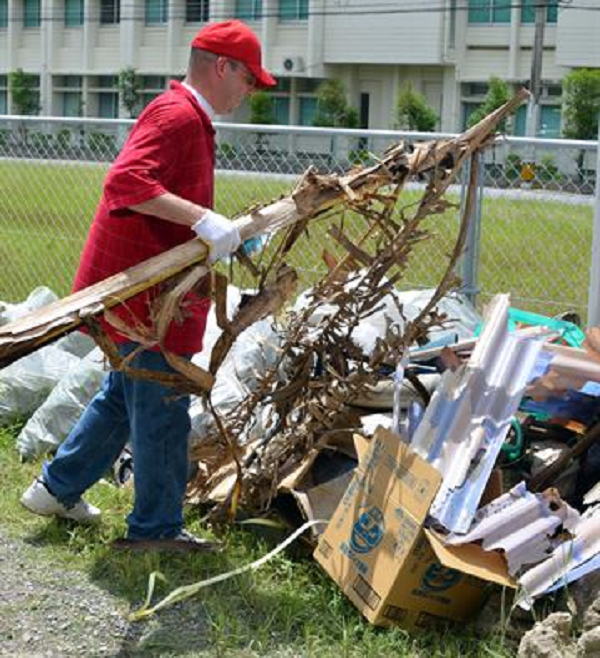What To Do About Piles of Crap?
Tuesday, September 5, 2017


Pile That Trash!
There is a universal design approach to handling the barriers of fall and winter, but the reality is that it requires real customization and thought long before the barrier appears. Since it is early fall, I thought I’d summarize the universal design approach before expanding the possibilities with a social support approach I ran across recently.
If you have the luxury of designing your home from scratch, you can do a lot to dramatically reduce the need for removal, and to prepare for the snow that will inevitably accumulate. Even if you rent in a high snow area, there are still things you can do:
“General Preparation And Supplies
- Stock up on non-perishable food – high calorie is more efficient
- Stock up on prescription and over-the-counter drugs
- Stock-up on water; if an emergency is expected, fill up containers and bathtubs.
- A first-aid emergency kit; supplement it with any special items you need.
- Batteries (special ones for health gadgets too)
- Battery powered radio; hand crank is good too.
- Means for communication: Most phones today require electric to work; make sure you have an old, no-frills phone that needs no more than a basic phone land-line connection. Cell phones will work if you can keep them powered and if the service isn’t congested.
- Blankets – plenty
- Matches and/or lighters
- Snow shovel, snow pusher, ice chipper or snow blower – smaller shovels lift less weight are easier on the back
- Needed supplies in good working order – as if they might have to for 7-14 days.
- I wish I didn’t have to add this, but in some cases this is important: have personal protection, something with which you can defend your home and protect your family should that become necessary.
- Supplies for pet needs too.”
These recommendations are useful for any emergency loss of community travel and use.
You will need to customize your approach to removal as well. There are lots of options if you prepare, and almost none if you wait until the snow has fallen. Have your system in place long before flakes fall. I’ve included two core links for this issue below, but the blog that published those linked posts contains a wide variety of additional home-focused frameworks for successful accommodation.
Similarly, there are variations for other barrier and trash removal, though again they must be customized.
As an adjunct to universal design approaches, I describe below a framework which I believe would be an important enhancement to your preparation, based on a social support model.
I attended one of a series of the meetings for the creation of an Age-Friendly Plan for Lansing Michigan that included a discussion of how to manage the removal of snow, grasses, leaves, and trash. The discussion reminded me of the ongoing, seemingly insoluble social problem of such removal by persons with disabilities that make standard removal a problem.
There is a common set of barriers and practices in all municipalities and rural areas that make clearance of these barriers to movement for people with disabilities problematic:
- Automatically devaluing the clearing of barriers if the beneficiaries of clearing are PWD
- The use of fines and other sanctions if clearing is not done by PWD themselves. This often necessitates expenses by people who are already poor, sometimes at a premium cost since PWD “have no other choice” but to contract for private clearing or face fines.
- The use of disability access parking spots and curb cuts as storage for large snowfall, on the assumption that PWD won’t be using them anyway.
- Requiring self-transport of hazardous materials for annual collection when PWD can’t use any transportation to do this. This requires someone else to do it, and all the coordination that entails, or it requires ignoring the hazard.
- And so on…..
These are all barriers that define removal as the total responsibility of the person who happens to have the barrier on their property, regardless of property ownership. This is true even when the “trash” is a tree that fell from city property onto private property, as occurred during the ice storm in 2013 in our local area.
The person on the private property was threatened with fines unless she removed it, something that was impossible because of her disability and her poverty. A solution was negotiated to resolve this, but the rules weren’t changed or modified to prevent this wrongful sanctioning in the future.
The proposal in the Age-Friendly workgroup (which I think is a good one) is to make support for such barrier removal a part of an integrated volunteer use system that would cover many neighborhood issues that are infrequent. This idea is one thread of a general proposal to make volunteering and volunteer work easier throughout the range of volunteer activities in the greater Lansing area.
I view such a proposal as a form of Assistive Social Technology (AST) in which community supports provide an ongoing solution to infrequent access issues, along with other neighborhood issues that are infrequent but need resolution. Potentially, there is both a digital/mobile aspect as well as the more obvious social one to such activity.
Such a “model” is already being done by some local people either through existing social relationships, spontaneous generosity, or deliberate local block organizing to assure that both older people and people with disabilities get support in removal. Rather than create an official program which will not change the low priority given to removal of barriers in a short term emergency, building a volunteer community effort where removal is a part of a general ongoing response to local need is a much better solution.
(I am going to try to develop the idea of AST for a future post.)
Surviving Snow & Ice: PREPARING FOR WINTER
Surviving Snow & Ice: SNOW REMOVAL
Lansing Age-Friendly Plan Website
Disability – Snow and Yard Waste Removal Problems

